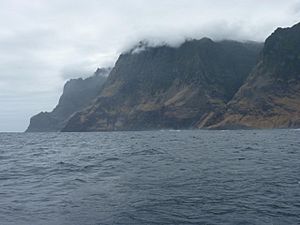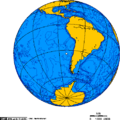Alejandro Selkirk Island facts for kids
|
Native name:
Isla Alejandro Selkirk
|
|
|---|---|

A map of Alejandro Selkirk Island
|
|
 |
|
| Geography | |
| Location | Pacific Ocean |
| Coordinates | 33°45′04″S 80°47′00″W / 33.75111°S 80.78333°W |
| Type | Volcanic island |
| Archipelago | Juan Fernández Islands |
| Area | 49.5 km2 (19.1 sq mi) |
| Highest elevation | 1,268 m (4,160 ft) |
| Highest point | Cerro de Los Inocentes |
| Administration | |
| Demographics | |
| Population | 57 |
Alejandro Selkirk Island (Spanish: Isla Alejandro Selkirk) is the largest and most western island in the Juan Fernández Islands group. It's part of Chile and sits in the southeastern Pacific Ocean. This island is about 180 kilometers (112 miles) west of Robinson Crusoe Island.
The island was once called Más Afuera, meaning "Farther Out (to Sea)". It was renamed after a real sailor named Alexander Selkirk. He was left alone on one of these islands from 1704 to 1709. His amazing survival story is thought to have inspired the famous book Robinson Crusoe by Daniel Defoe. To celebrate this history and bring in visitors, the Chilean government changed the island's name to Alejandro Selkirk Island in 1966.
| Top - 0-9 A B C D E F G H I J K L M N O P Q R S T U V W X Y Z |
Island Geography
Alejandro Selkirk Island is about 11 kilometers (7 miles) long from north to south. It is also about 6 kilometers (4 miles) wide from east to west. The island covers an area of about 49.5 square kilometers (19.1 square miles).
This island is very mountainous and covered in thick forests. It has many ridges and deep ravines. These ravines lead to a steep, rocky coast on the east side. The cliffs along the coast can be as high as 1,000 meters (3,280 feet).
On the south, west, and north sides, there are sandy beaches. These beaches can stretch out about 161 meters (528 feet) into the sea in some places. The highest point on the island is Cerro de Los Inocentes. This peak rises to 1,268 meters (4,160 feet) in the southwest.
Alejandro Selkirk Island is the top of a submarine volcano. This volcano formed during the Pleistocene period. Rocks on the island show it is the youngest of the Juan Fernández Islands. It is only about 1 to 2 million years old. Because it is so young, the island does not show much erosion.
Island Climate
Alejandro Selkirk has a subtropical climate. This means it's generally warm, but not too hot. The weather is made milder by the cool Humboldt Current and the southeast trade winds.
Temperatures on the island usually range from 3°C (37°F) to 34°C (93°F). The average temperature for the year is about 15.4°C (59.7°F). Higher areas on the island are usually cooler.
The island gets about 1,081 millimeters (42.6 inches) of rain each year. This amount can change a lot from year to year. It rains more in the winter months. Areas above 500 meters (1,640 feet) get rain almost every day.
Plants and Animals

Alejandro Selkirk Island is home to some unique animals. The Juan Fernández fur seal was once very common here. In the late 1600s, millions of these seals lived on Alejandro Selkirk and Robinson Crusoe islands. However, they were hunted so much that they almost disappeared. For 100 years, people thought they were extinct. But in 1965, about 200 were found on the island. Since then, their numbers have been growing steadily.
The Masafuera rayadito is a very rare bird found only on Alejandro Selkirk Island. It is one of the rarest birds in South America. There are only about 140 of these birds left.
Sadly, another bird, the Alejandro Selkirk firecrown, is now extinct. This bird was a type of Juan Fernández firecrown. It died out in 1908 because of wild goats and other animals brought to the island.
The island is recognized as an Important Bird Area (IBA). This means it's a special place for birds. It supports populations of Stejneger's petrel and Juan Fernandez petrel.
The plants on the island are also very special. Many plant species found here grow nowhere else in the world.
Island History
For most of its history, Alejandro Selkirk Island was not lived on by people. There used to be a place where prisoners were sent, called a penal colony. It was located along the middle of the east coast. This settlement operated from 1909 to 1930. It first held 190 criminals. Later, it held up to 160 political prisoners. The penal colony was closed in 1930.
More recently, people have started to live on the island regularly. In 2012, there were 57 people living there.
In 1966, the Chilean government changed the island's name from Isla Más Afuera to Alejandro Selkirk Island. At the same time, Más a Tierra island became Robinson Crusoe Island. These names honor Alexander Selkirk, the Scottish sailor who was left alone on Más a Tierra from 1704 to 1709. His incredible story of survival likely inspired the famous 1719 novel Robinson Crusoe by Daniel Defoe.
See Also
 In Spanish: Isla Alejandro Selkirk para niños
In Spanish: Isla Alejandro Selkirk para niños
- Flora of the Juan Fernández Islands
- Endemic flora of the Juan Fernández Islands
- Endemic fauna of the Juan Fernández Islands
Images for kids





